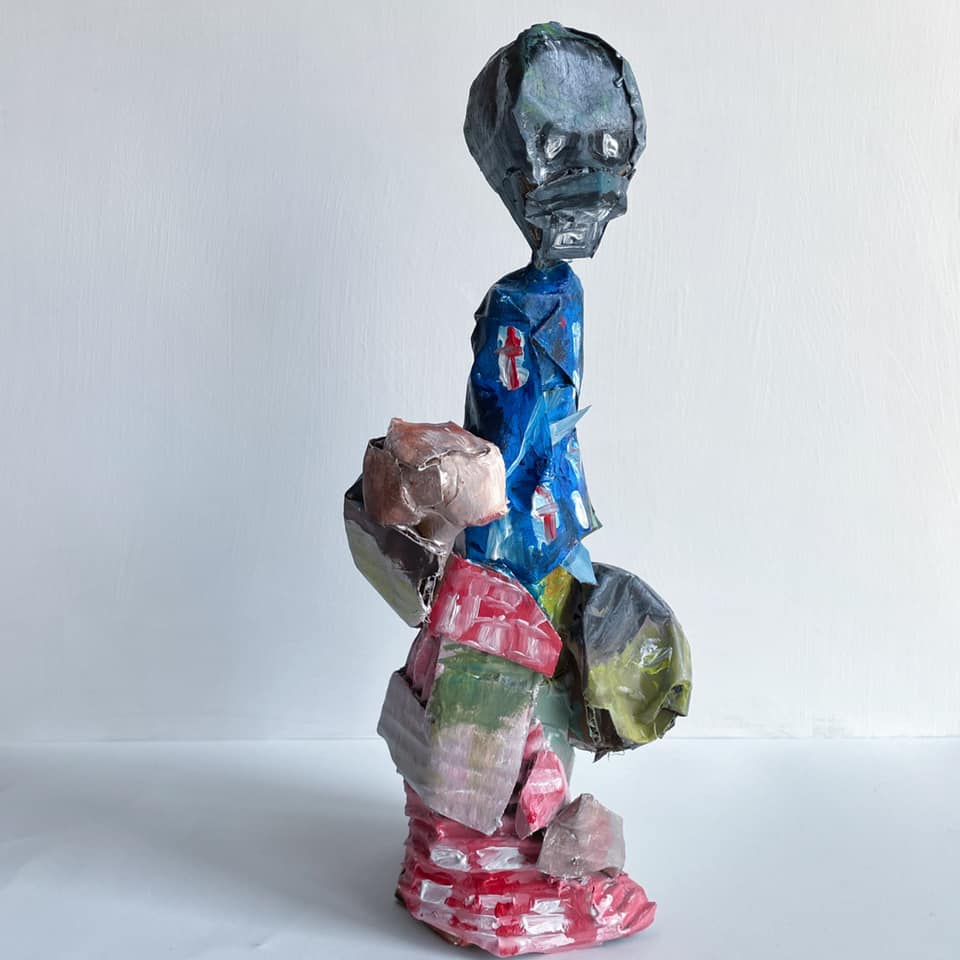
Cover photo: a 3-dimensional art design by Jaime Mutschler, representing the character of Death in Gustav Klimt’s 1911 oil on canvas painting entitled Death and Life, shown here
(courtesy of Wikipedia)
Congratulation Edgewalkers! We have passed through the darkest of times on the solar calendar. December marked the winter solstice, the shortest day of the year. Like many Canadians, I was commuting in the dark, both to and from work. I will admit that I felt the effects of long weeks of bitter cold and dark. I felt tired. I lost interest in removing any more snow from around my house. I did not want to go outside anymore. Can you relate to what I am saying? Can you feel me?
Couple the short days and wintry weather with the reality of 2+ years of COVID-19 restrictions and all the uncertainties that come with self-isolation, related short and long-term illness and even death, and we had, and still have, a recipe for heightened stress, anxiety, and depression. But now here we are, the spring equinox is safely behind us, and we are on our way to sunnier, warmer days. Bring on the Vitamin D!
In February, I sent a survey into the universe with the goal of gathering information from Edgewalkers in all directions at all distances. I wanted to hear about our current state of mental wellness and collect tips, tricks, and best practices in managing stress and anxiety. My response to what you told me is in the pages to follow, along with your suggested anxiety-busters.
Anxiety 101
I typically prefer to leave topics such as stress and anxiety to psychiatric and psychological professionals. However, tongue-in-cheek, I am a user of anxiety. I am a feeler of the product. I carry some of it with me everywhere I go. As a Strategic Change Consultant in my day job, I have a responsibility to myself and others in my care to pay attention to truths, trends, and solutions related to stress and anxiety.
There are at least eleven different types of anxiety, and these may not even include anxiety that we experience related to other conditions such as stress, depression, trauma, or even chemical imbalances such as hormonal fluctuations or changes related to medications or mood-altering drugs. So, even to try to define anxiety at its core is a tricky thing to do. These truths may even increase anxiety as we experience it.
The personality of Anxiety

As a society, we have not done ourselves any favours with the language we have formed over the years regarding stress, anxiety, and depression. We use phrases such as “my anxiety” to describe how we are feeling. We may even say “I am anxious” or “I am depressed” or “I am stressed”.
My preference, and I believe a much healthier way of using language related to such things, is to recognize the narrative of it all: the story of how the condition has found its way into my life. For example, when we enter the winter season, we see a decrease in hours of sunlight in our part of the world. Seasonal depression or seasonal anxiety are a result of this environmental change. We often use language like “I have seasonal depression.” We even experience increased anxiety as we anticipate the future potential of seasonal depression. But the narrative approach looks much different.
Anxiety has a narrative, a story all its own. Anxiety’s story is not my story. I do not have the rights to it. It is not mine to take or to own. My story just happens to intercept or cross Anxiety’s story every so often. Just like most house pets, Seasonal Depression and Anxiety seek to stay indoors where it is safe when the weather turns colder, and the nights grow longer. As a result, I experience their stories much more intimately than at other times of year. And, just like a pet, Anxiety is dependent upon me to pay attention to it and feed it. My goal needs to be finding ways to limit the attention I give Anxiety by taking care of myself first. Anxiety will eventually be more likely to either move on or at least go curl up on a pillow in the corner where it is more manageable.
Normal or problematic anxiety, pandemics and transitions
I have learned a few things about stress and anxiety over the years by dealing with my own and helping other face theirs. First, it is important to understand that anxiety is a normal reaction to many kinds of events and situations. Anxiety is one of many internal warning systems that alert us to danger or other threats and prepares our bodies to fight back or get out of a dangerous situation (fight, flight, or freeze).
A manageable amount of anxiety or stress from time to time can be helpful, such as when we are preparing for a test, job interview, or finishing a task at work. Even happy events like moving to a new home or celebrating an important milestone can bring up anxiety—all of this is just part of being human.

Your responses to some of my questions show consistency with the observations of health professionals, counsellors, professional coaches, and HR departments. We are noting a general increase of people requiring professional assistance with anxiety since the onset of the Pandemic in Spring 2020. Professionals explain that people who would typically be in the normal range of experiencing anxiety, the prolonged nature of life stressors such as the pandemic are pushing them from the normal range into the problematic range.
Anxiety is a problem when it becomes overwhelming or unmanageable and/or when anxiety comes up unexpectedly. We may avoid going about our daily lives to avoid anxiety. This may show up by calling in sick more often than normal or backing out of plans with friends and family.
Anxiety can cause us to experience a lot of uncomfortable physical sensations and physical health problems. We may know our feelings of anxiety aren’t based in reality, but still feel ‘trapped’ by my thoughts and feelings.
I wish to emphasize at this point that anxiety disorders are treatable. It’s important to seek help if you’re concerned about anxiety in your life. The earlier anxiety is detected and treated, the better the outcome.
Anxiety in the workplace: what’s going on?
When stress-causing situations are prolonged, the impact of stress becomes more pronounced and might show up as increased anxiety. We have no shortage of stressors in the workplace and in our society these days. We are just over two years into a global pandemic that has significantly changed the way we relate to each other.
Some of us may be in the process of downsizing, changing office spaces, or transitioning back to the office from working from home. Uncertainty is alive in many of these situations. When we are feeling elevated anxiety, our “anxiety voice” fills in the blanks of uncertainty or the future with worst-case scenarios.
It is important to remember that we are all experiencing certain amounts of stress and anxiety, normal or problematic. It is a natural part of living. No matter our place in the organization, there are no exceptions. The difference lies in how we cope with anxiety and stress.
Years ago, I worked for the Saskatchewan regional office of a national organization. We were experiencing universal cutbacks and downsizing. Position cuts were happening by the thousands across the country, budgets were getting slashed, and morale had nosedived. Stress and anxiety abounded. We were having a regional “all-staff” and senior leader accepted an invitation to come from the central office as a guest for an armchair discussion. I heard rumblings from different groups of people saying things like, “I can’t wait until he gets here and then, boy, we’re really gonna nail him to the wall.” The day came and there he was with our other senior managers on stage, taking questions. One employee came to the microphone and said in a sneer: “This is for you, Mister Senior Leader – I wanna know what keeps you up at night.” There was a pause as the senior leader prepared to respond. Instead, he broke down in tears, and then finally said, “I am kept up at night knowing what’s happening to all of you, people I am responsible for, and there’s nothing I can do about it.”
My point is this–no matter where we are in the organization or the community, we feel anxiety and stress. Our paths cross with the paths of stress and anxiety. Sometimes we cope better than other times.
Good ideas for overcoming anxiety
As promised when I first sent out our survey, I have compiled a list of responses to the questions asked. These responses are as follows:
If anxiety is affecting a co-worker, when and how is the best way to respond?
- Reach out and offer to talk with them, but keep it casual
- Create a safe space where they may feel comfortable to talk–this is easier done as an ongoing habit rather than trying to establish the safe space only after we see individuals experiencing anxiety
- Do what is most comfortable for your co-worker, not what is most comfortable for me.
What are some coping mechanisms that can help us deal with anxiety?
 Breathing exercises
Breathing exercises- Physical exercise (work out, or go for a walk)
- Take a day off for self-care
- Reach out to a support system such as friends or family
- Get a good sleep
- Do a wellness inventory or health-check to identify where the stress is coming from
- Be aware of triggers and remove the likelihood of experiencing them
- Talk it out with a close friend or confidant
- Laugh– it changes our breathing patterns back to a more natural rhythm
- Be creative, paint, sing, dance, or write a poem
What are some tips and tricks you practice to help you successfully through the day?
 Positive attitude
Positive attitude- Take a break, go for a walk, or find a distraction
- Listen to relaxing music, or listen to music that can help ‘dance it out’
- Wait to respond to emails and phone messages until in a good headspace
- Breathing exercises and meditation
- Find a way to remove or reduce the stressor
- Find a good morning routine and keep it
- Have a good laugh
- Find a way to get into nature
- Professional support
- Good posture and positioning
- Manage a healthy schedule
- Stay hydrated
- Look forward to something at the end of the day; self-reward for ‘crushing it’
- *Someone said, “eat chocolate”. I admit that I love the simplicity and honesty of your answer
Help is available
Edgewalkers, I would like to leave you with a final thought. You are not alone. Reach out to someone you feel comfortable to confide in. Perhaps a co-worker, manager or mentor. Perhaps a coach, or friend. Perhaps a family member.
It’s okay to seek professional help. Reach out to your doctor, or employer-supported Employee and Family Assistance Plan (EFAP).
Or contact one of the following:
Anxiety Canada: www.anxietycanada.com
Canadian Mental Health Association (CMHA): www.cmha.ca; 1-800-461-5483
Donovan Mutschler, MA, MC
For more information on this or other topics of interest contact Donovan Mutschler at donovan@edgewalkers.ca.
Be First to Comment